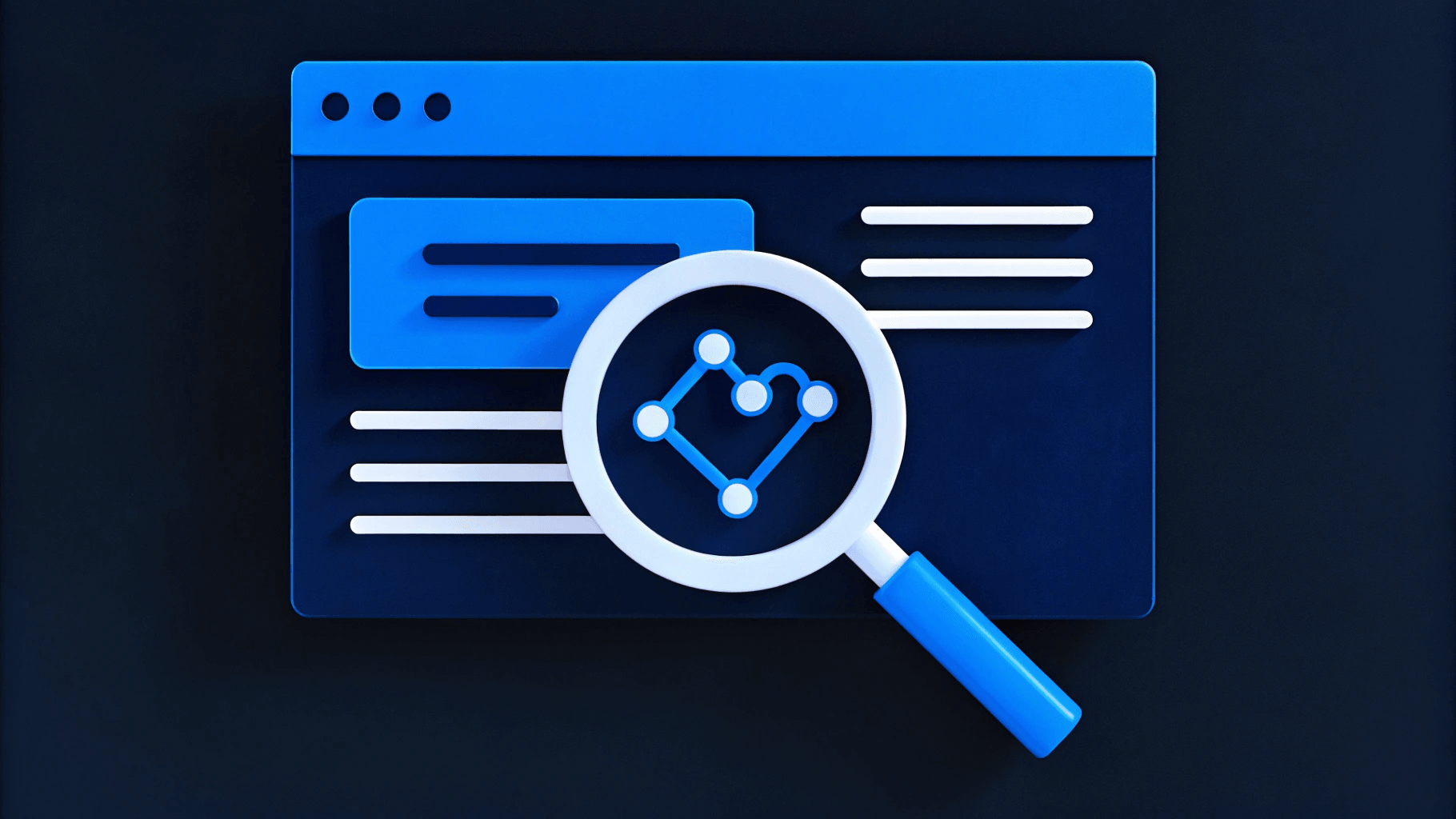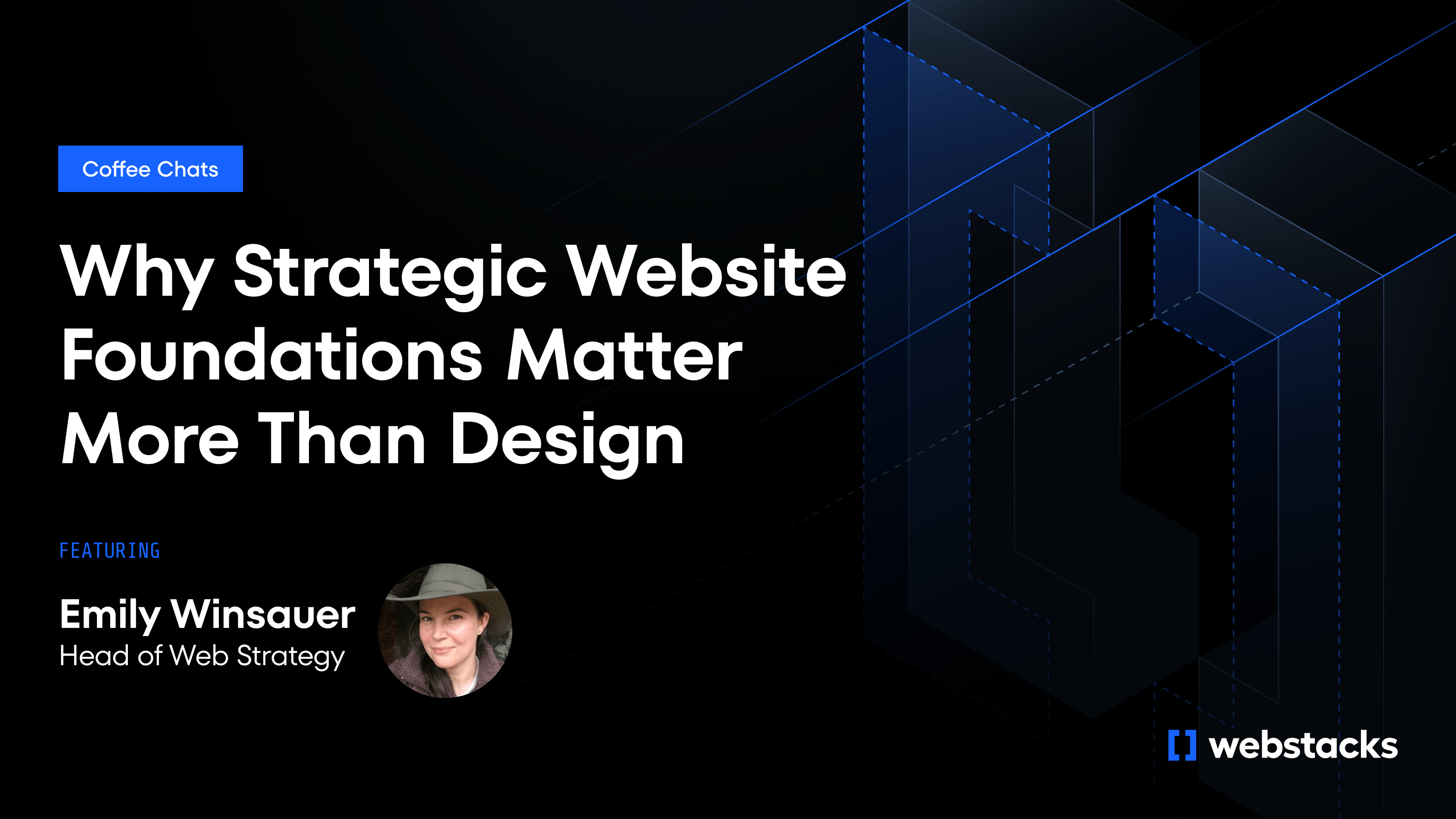Website managers juggle performance, scalability, and security through disconnected systems that create blind spots. The rise of AI-driven search engines and LLMs means your site must now satisfy both human visitors and AI crawlers simultaneously, while traditional monitoring tools struggle to keep pace.
Modern web operations (WebOps) generate massive data streams from server logs, user interactions, and performance metrics. Manual analysis of this information leads to reactive firefighting rather than proactive optimization.
AI transforms this landscape by detecting anomalies faster than human analysts, predicting issues before users experience problems, and automating routine operational tasks. Your website's visibility in next-generation search engines directly depends on AI-friendly optimization and intelligent performance management.
This guide provides a structured implementation framework for integrating AI across web operations to cut downtime, maximize resources, and create exceptional user experiences while making your site discoverable in AI-powered search results.

What is AI for Web Operations?
AI for web operations refers to the application of machine learning algorithms, natural language processing, and predictive analytics to automate, optimize, and enhance various aspects of website management. Unlike traditional rule-based systems, AI-powered WebOps solutions can learn from data patterns, adapt to changing conditions, and make intelligent decisions without explicit programming for every scenario.
In the WebOps context, AI serves as an intelligent layer that sits between your infrastructure and your team, continuously analyzing data streams from various sources, such as server logs, user behavior metrics, performance indicators, and security events. It transforms this raw data into actionable insights and automated responses, which enables proactive management over reactive firefighting.
AI transforms web operations across four key areas:
- Predictive Analytics: AI replaces traditional threshold-based alerts with intelligent pattern recognition that detects subtle anomalies before they impact users. It analyzes multiple metrics simultaneously for accurate root cause identification and reduces false positives.
- Intelligence Automation: Smart alerting correlates events across systems to identify underlying causes automatically. Advanced AI can roll back faulty deployments, provision resources dynamically, and execute remediation workflows based on past incidents.
- Real-time Personalization: AI enables real-time personalization that adapts content, recommendations, and layouts based on individual behaviors. Machine learning identifies user segments with similar patterns and optimizes content delivery, navigation paths, and interface elements to reduce friction and improve conversion rates.
- Continuous Compliance: Automated monitoring ensures ongoing adherence to security standards and regulatory requirements. AI detects suspicious patterns that might indicate attacks, classifies sensitive data automatically, and generates compliance reports without manual intervention.
HeyGen exemplifies this approach brilliantly. During their explosive growth phase (scaling from $0 to $1M ARR in just 7 months), Webstacks helped them build an interactive Stock Avatars page that uses AI to personalize the experience. Visitors can explore AI-generated avatars through live preview cards that autoplay sample clips, creating an engaging, product-led experience that contributed to their AI Tools Directory attracting 25,000 organic users in its first month alone.
Step-by-Step Process to Implement AI in Web Operations
A structured WebOps approach that combines technical discipline with clear business objectives delivers sustainable results. This eight-step roadmap guides you from initial assessment to organization-wide implementation.
1. Assess Your Current WebOps
Start with a comprehensive audit of your existing web operations. Document your current tools, processes, and performance baselines. This assessment creates the foundation for prioritizing AI implementations that deliver maximum value.
Inventory Current Infrastructure
Create a comprehensive catalog of your existing technology stack to understand integration requirements and identify potential compatibility issues before implementing AI solutions.
- Document all monitoring tools, content management systems, and security solutions
- Map data flows between systems and identify integration points
- Assess API availability and technical compatibility requirements
- Review current automation capabilities and workflow processes
Document Performance Baselines
Establish precise measurements of current operational metrics. Analyze performance metrics, including:
- Average response times and uptime percentages
- Mean time to resolution (MTTR) for incidents
- False positive alert rates and alert volume
- Manual task time allocation across team members
Review your content management workflows and look into how content is created, updated, and delivered to users.
Risk and Readiness Evaluation
Assess organizational constraints and capabilities that will impact AI implementation success, ensuring realistic project planning and appropriate resource allocation.
- Regulatory Requirements: Identify compliance obligations (GDPR, HIPAA, SOX) that impact AI implementation
- Data Sensitivity: Classify information types and access requirements
- Technical Debt: Document legacy systems without API access that may block integration
- Team Capabilities: Assess current AI/ML expertise and training needs
- Change Management Readiness: Evaluate organizational appetite for process changes
Identify Common Challenges
Survey your teams to understand daily operational pain points. For example:
- Time spent on manual log analysis
- Frequency of reactive incident response
- Capacity planning accuracy
- Performance bottleneck identification delays
This assessment creates the foundation for prioritizing AI implementations that will deliver the most value.
2. Choose the Right AI Tools and Platforms
Select AI solutions based on specific operational pain points rather than feature completeness. Match your documented challenges with targeted capabilities while ensuring seamless integration with existing infrastructure.
Evaluation Framework
Apply these systematic assessment criteria to each AI tool category, ensuring your selections address specific operational challenges while maintaining compatibility with existing infrastructure:
Monitoring and Visibility:
- Problem-Solution Fit: Choose solutions that provide comprehensive performance tracking with intelligent anomaly detection for your specific infrastructure
- Integration Compatibility: Prioritize platforms that correlate metrics across multiple systems and connect seamlessly with your existing monitoring stack
- Performance Scalability: Ensure tools can handle your traffic spikes and data volume growth without degrading analysis quality
Incident Response and Alerting:
- Problem-Solution Fit: Select tools that reduce alert noise through intelligent correlation and prioritization of your specific incident patterns
- Integration Compatibility: Ensure seamless connection with existing communication channels (Slack, PagerDuty, email) and ticketing systems
- Support Ecosystem: Verify robust documentation and community resources for troubleshooting complex alerting scenarios
Advanced Observability:
- Problem-Solution Fit: Evaluate platforms offering predictive capabilities and automated root-cause analysis for your technology stack
- Performance Scalability: Consider solutions that extend monitoring into cloud infrastructure and scale with your deployment complexity
- Integration Compatibility: Assess API quality and data export capabilities for custom dashboard creation
Security Monitoring:
- Problem-Solution Fit: Implement AI-powered security tools that detect behavioral anomalies relevant to your specific threat landscape
- Integration Compatibility: Choose solutions that integrate with existing security information and event management (SIEM) systems
- Support Ecosystem: Evaluate vendor security expertise and incident response support capabilities
Architecture Considerations
Evaluate deployment options based on your risk assessment:
- On-premises solutions for sensitive data or strict compliance requirements
- Cloud-native platforms for rapid scaling and managed infrastructure
- Hybrid approaches that balance control with operational efficiency
Proof-of-Concept Testing
Never rely solely on vendor demonstrations. Implement limited trials using your actual data and infrastructure to validate performance claims. Test integration complexity, accuracy metrics, and resource requirements under realistic conditions.
Low-Code Implementation Options
For organizations with limited AI expertise, consider platforms that accelerate deployment without extensive custom development. UpKeep's implementation exemplifies this approach—they integrated an AI Checklist Generator and intelligent search using OpenAI's API within their existing DatoCMS and Gatsby architecture, achieving functionality without complete system rebuilds.
3. Define Clear KPIs and Metrics for Success
Avoid abstract discussions about "better performance." Transform goals into precise, measurable indicators that demonstrate tangible business value. Well-defined KPIs demonstrate value, justify budgets, and counter perceptions that AI is experimental spending.
Technical Performance Metrics
Track these core indicators to measure AI system effectiveness and validate operational improvements against baseline measurements:
- Mean Time to Resolution (MTTR): Target specific reduction percentages (e.g., 40% improvement within six months)
- False Positive Alert Reduction: Measure alert accuracy improvements and team efficiency gains
- System Uptime: Track availability improvements and incident frequency reduction
- Response Time Optimization: Monitor page load speed improvements and user experience metrics
Business Impact Indicators
Measure how AI implementations translate into tangible business value and organizational efficiency gains:
- Operational Efficiency: Measure time savings on manual tasks and resource reallocation opportunities
- User Experience Improvements: Track conversion rate changes and user satisfaction metrics
- Cost Optimization: Monitor infrastructure cost changes and operational expense reduction
Short-term and Long-term Target Setting
Define realistic improvement objectives with specific timelines to maintain momentum and demonstrate progress:
- 30-day goals: Quick wins like reduced false positive alerts or improved monitoring coverage
- 90-day objectives: Measurable MTTR improvements and basic automation deployment
- 6-month targets: Significant uptime improvements and advanced AI feature activation
- Annual aspirations: Comprehensive AI integration with predictive capabilities
Dashboard and Reporting Framework
Create accessible performance dashboards for both technical teams and business stakeholders with appropriate detail levels:
- Real-time KPI monitoring with clear trend visualization
- Automated alert systems for significant metric deviations
- Regular review schedules with stakeholder-appropriate detail levels
- Integration with existing business intelligence and reporting tools
4. Gather and Prepare Data for AI Models
Your AI's performance depends entirely on data quality and accessibility. Establish robust data pipelines and governance frameworks that support reliable model training and ongoing performance optimization.
Comprehensive Data Source Mapping
Catalog all operational data sources to ensure AI models have access to complete information for accurate analysis and decision-making:
- Server and Application Logs: Web server access logs, application error logs, database performance metrics
- User Interaction Data: Click streams, session recordings, conversion funnel metrics
- Infrastructure Metrics: CPU utilization, memory usage, network latency, storage performance
- Security Events: Authentication logs, firewall events, intrusion detection alerts
- Business KPIs: Revenue metrics, customer satisfaction scores, operational costs
Data Quality Assurance
Establish systematic processes to ensure AI models receive clean, consistent data that enables accurate pattern recognition and reliable predictions.
- Duplicate Removal: Identify and eliminate redundant records across data sources
- Missing Value Handling: Establish consistent approaches for incomplete data sets
- Format Standardization: Ensure consistent data types, units, and naming conventions
- Timestamp Synchronization: Align time-based data across systems for accurate correlation analysis
Governance and Compliance Framework
Implement data management policies that protect sensitive information while enabling AI systems to access necessary operational data:
- Access Control: Define role-based permissions for sensitive operational data
- Retention Policies: Specify data storage duration and archival procedures
- Privacy Protection: Implement anonymization for personally identifiable information
- Audit Trails: Maintain comprehensive logs of data access and modifications
- Regulatory Compliance: Ensure adherence to relevant data protection regulations
Historical Incident Documentation
Create detailed incident databases that enable AI models to learn from past failures and improve predictive accuracy:
- Root Cause Classification: Tag historical outages with specific failure categories
- Resolution Documentation: Record successful troubleshooting steps and fix procedures
- Impact Assessment: Document user impact, revenue effects, and recovery timelines
- Pattern Identification: Note recurring issues, seasonal trends, and environmental factors
Data Pipeline Architecture
Build scalable infrastructure capable of processing high-velocity operational data for real-time AI analysis and decision-making:
- Real-time Streaming: Implement systems capable of processing high-velocity operational data
- Batch Processing: Establish scheduled processing for historical analysis and model training
- Storage Solutions: Deploy appropriate data lakes or warehouses for AI-specific requirements
- Integration APIs: Create standardized interfaces for consistent data access across AI tools

5. Train and Deploy AI Models
Transform prepared data into operational AI systems through systematic model development, testing, and deployment processes that minimize risk while maximizing performance impact.
Algorithm Selection by Use Case
The effectiveness of your AI implementation depends heavily on matching the right machine learning algorithms to your specific operational challenges. Different types of problems require different analytical approaches, so consider your data characteristics and desired outcomes when making these critical technology decisions.
- Unsupervised Learning: Deploy clustering and anomaly detection algorithms for identifying unusual system behavior patterns
- Supervised Learning: Implement classification and regression models for incident prediction using labeled historical data
- Time Series Analysis: Apply forecasting algorithms for capacity planning and traffic prediction
- Gradient Boosting: Utilize for smaller datasets where it often outperforms complex neural networks
Development Environment Setup
Proper model development requires controlled environments that replicate production conditions without risking operational stability. Creating realistic testing scenarios ensures your AI models will perform accurately when deployed to live systems.
- Data Subset Testing: Train initial models using representative historical data samples
- Cross-Validation Implementation: Ensure models generalize well to unseen data patterns
- Algorithm Benchmarking: Compare multiple approaches to identify optimal performers for specific use cases
- Performance Validation: Test model accuracy, response times, and resource requirements
Integration Testing Protocols
Comprehensive testing of AI system connections with existing infrastructure prevents costly deployment failures and operational disruptions. Validating all integration points before production deployment ensures seamless functionality and maintains system reliability.
- API Compatibility: Verify seamless communication with existing monitoring and management tools
- Data Flow Validation: Confirm accurate real-time data processing and model input handling
- Dependency Mapping: Test integration stability under various system load conditions
- Rollback Procedures: Establish quick reversion processes if AI systems cause operational issues
Staged Production Deployment
Deploying AI systems directly to full production environments creates unnecessary risk and potential for widespread operational impact. A graduated rollout approach allows you to identify and resolve issues while limiting exposure to critical systems.
- Non-Production Testing: Deploy models in staging environments with production-like data
- Feature Flag Implementation: Use toggles for instant activation or deactivation of AI features
- Canary Releases: Gradually expose AI systems to increasing percentages of production traffic
- Performance Monitoring: Track model accuracy and system impact during rollout phases
Continuous Integration Pipeline
Manual model deployment processes are error-prone and time-consuming, creating bottlenecks that slow AI system improvements. Automated pipelines ensure consistent, reliable updates while maintaining quality standards through systematic validation.
- Automated Testing: Implement validation checks for model accuracy and integration stability
- Version Control: Maintain comprehensive tracking of model changes and performance comparisons
- Deployment Automation: Streamline the process of moving validated models from development to production
- Monitoring Integration: Automatically track deployed model performance against established baselines
OctoAI's implementation demonstrates effective production deployment. Their website integration includes interactive demos of core AI models (Stable Diffusion, Llama 2 Chat, Whisper) that maintain performance while providing visitors hands-on experience with AI capabilities, completed through a systematic 6-week deployment process.
6. Automate Workflows and Tasks with AI
With validated AI models in production, integrate them into daily operational workflows through strategic automation that enhances human capabilities while maintaining appropriate oversight and control mechanisms.
Automation Readiness Assessment
Not all operational processes are suitable for immediate AI automation—successful implementation requires strategic selection based on complexity, risk, and potential impact. Start by evaluating your workflows systematically to identify the best candidates for initial automation efforts. Evaluate processes for AI integration based on three key factors:
- Task Frequency: Prioritize repetitive activities that consume significant manual effort
- Process Complexity: Start with well-defined procedures that have clear success criteria
- Risk Tolerance: Begin with low-impact automations before progressing to critical operations
Initial Automation Targets
Begin your automation journey with well-understood, repetitive tasks that have proven solutions and minimal risk if something goes wrong. These foundational implementations build confidence and demonstrate value while you develop expertise. Focus first implementations on proven use cases:
- Log Analysis: Automated parsing and pattern recognition in system logs
- Report Generation: Scheduled creation of performance and incident summaries
- Basic Troubleshooting: Automated diagnosis and resolution of common system issues
- Performance Monitoring: Dynamic threshold adjustment based on historical patterns
Progressive Automation Deployment
Rushing into full automation without proper validation can create more problems than it solves, potentially damaging trust in AI systems. A gradual approach allows you to refine processes, build confidence, and maintain operational stability.
- Shadow Mode: Run AI systems in parallel with manual processes to validate accuracy
- Approval Workflows: Require human confirmation for high-impact automated actions
- Feedback Integration: Capture human corrections and exceptions to improve AI performance
- Guardrail Implementation: Establish automatic safety mechanisms and rollback triggers
Advanced Automation Applications
Once your initial automation implementations prove successful and stable, you can confidently expand to more complex and critical operational areas. These sophisticated use cases deliver greater business impact but require the foundation of proven AI reliability.
- Performance Optimization: AI-driven content delivery network configuration and resource allocation
- Incident Response: Automated correlation of events across systems with intelligent escalation
- Content Personalization: Dynamic website element arrangement based on user behavior patterns
- Security Response: Automated threat detection with immediate containment actions
Human-AI Collaboration Design
Effective automation enhances human capabilities rather than simply replacing them, creating systems where AI handles routine tasks while humans focus on strategic decisions. Design your workflows to leverage the unique strengths of both human intelligence and artificial intelligence.
- Decision Transparency: Provide clear explanations for AI recommendations and actions
- Override Capabilities: Enable human intervention when circumstances require manual control
- Skill Development: Use AI insights to improve human troubleshooting and optimization capabilities
- Escalation Protocols: Define clear handoff points for complex or unusual situations
Integration with Existing Tools
AI automation systems must work harmoniously with your current operational tools and workflows to avoid creating disconnected processes. Seamless integration ensures that automated actions complement rather than disrupt established operational procedures.
- API Connectivity: Link AI systems with current monitoring, alerting, and management platforms
- Data Synchronization: Maintain consistent information across automated and manual processes
- Notification Systems: Integrate AI-generated alerts with existing communication channels
- Documentation Updates: Automatically update runbooks and procedures based on AI learnings
7. Monitor, Evaluate, and Fine-Tune AI Systems
AI systems require ongoing attention and refinement to maintain peak effectiveness. Implement comprehensive monitoring and optimization processes that ensure long-term success and adaptation to changing operational requirements.
Multi-Level Performance Monitoring
AI systems can degrade over time without proper oversight, making continuous performance tracking essential for long-term success. Monitor both technical metrics and business outcomes to ensure your AI investments continue delivering value.
Technical Performance Metrics:
- Model Accuracy: Monitor prediction accuracy and classification performance over time
- Response Times: Track AI system latency and impact on overall operational performance
- Resource Utilization: Measure computational costs and infrastructure impact
- Integration Stability: Monitor API reliability and data processing consistency
Business Impact Assessment:
- Operational Efficiency: Quantify time savings and resource reallocation achievements
- Incident Reduction: Track improvements in system reliability and user experience
- Cost Optimization: Measure infrastructure cost changes and manual effort reduction
- User Satisfaction: Monitor customer experience improvements and feedback trends
AI System Health Monitoring
Your AI infrastructure requires dedicated monitoring just like any other critical system component to prevent unexpected failures. Proactive health checks ensure AI systems remain reliable and perform within expected parameters.
- Model Performance Alerts: Automated notifications when accuracy drops below acceptable thresholds
- Data Quality Monitoring: Continuous validation of input data consistency and completeness
- Integration Health Checks: Regular testing of AI system connectivity with operational tools
- Resource Usage Tracking: Monitor computational resources to prevent system overload
Performance Degradation Detection
AI models can lose accuracy over time as data patterns change, making early detection of performance issues critical for maintaining operational effectiveness. Systematic monitoring helps identify problems before they significantly impact business operations.
- Data Drift Monitoring: Detect when incoming data patterns deviate from training datasets
- Model Staleness Indicators: Identify when models need retraining due to changing operational patterns
- Seasonal Adjustment Needs: Recognize when business cycles require model parameter updates
- Feedback Loop Analysis: Track the effectiveness of human corrections and system learning
Optimization Cycle Implementation
Regular, systematic improvements ensure AI systems continue evolving with your business needs rather than becoming static tools. Structured optimization cycles prevent performance stagnation and maximize return on AI investments.
- Performance Review Schedule: Conduct monthly technical reviews and quarterly business impact assessments
- Model Retraining Protocols: Define triggers and procedures for updating AI models with fresh data
- Parameter Tuning: Systematically adjust model configurations based on operational experience
- Feature Enhancement: Identify opportunities to expand AI capabilities based on usage patterns
User Feedback Integration
Human insights are invaluable for improving AI system accuracy and usability, as users often identify issues that automated monitoring misses. Systematic feedback collection creates a continuous improvement loop that enhances AI performance.
- Correction Tracking: Record when humans override AI decisions and analyze patterns
- Satisfaction Surveys: Regularly collect team feedback on AI tool effectiveness and usability
- Suggestion Implementation: Establish processes for evaluating and implementing user recommendations
- Training Updates: Use real-world feedback to enhance AI model accuracy and relevance
Technology Evolution Adaptation
The AI landscape evolves rapidly, and staying current with new capabilities ensures your systems remain competitive and effective. Regular assessment of emerging technologies prevents your AI implementation from becoming outdated.
- Vendor Updates: Evaluate new features and capabilities from existing AI tool providers
- Emerging Technologies: Assess new AI techniques that might improve operational efficiency
- Integration Opportunities: Identify chances to connect AI systems with additional operational tools
- Competitive Analysis: Monitor industry best practices and innovative AI applications
Alert fatigue prevention remains critical—when teams receive too many notifications, they begin ignoring all alerts. Regularly review and refine alerting rules based on actual resolution patterns and team feedback.
8. Scale AI Implementation Across Web Operations
After validating initial AI implementations, expand systematically across all web operations through structured scaling approaches that leverage proven successes while maintaining operational stability.
Expansion Prioritization Framework
Not all processes are equally suited for AI implementation, making strategic prioritization essential for efficient resource allocation and maximum impact. Focus expansion efforts on areas where proven AI patterns can be replicated successfully.
- High-Impact, Low-Complexity: Replicate successful patterns in similar operational areas
- High-Impact, High-Complexity: Develop dedicated project plans with extended timelines
- Quick Wins: Identify additional processes suitable for existing AI models
- Strategic Initiatives: Plan comprehensive AI integration for critical business functions
Organizational Readiness Development
Successful AI scaling requires organizational capability building beyond just technical implementation to ensure widespread adoption and effective usage. Invest in people, processes, and knowledge sharing to support enterprise-wide AI integration.
- Center of Excellence: Establish a dedicated team to share learnings and accelerate adoption
- Best Practice Documentation: Create detailed playbooks for common AI implementation scenarios
- Training Programs: Develop skills development initiatives for technical and business teams
- Change Management: Implement structured approaches for process modifications and team adaptation
Standardization and Reusability
Creating reusable frameworks and standards accelerates future AI deployments while reducing implementation complexity and costs. Systematic standardization prevents teams from recreating solutions that already exist elsewhere in the organization.
- Data Format Standardization: Establish consistent data structures across all operational systems
- API Interface Consistency: Create uniform integration patterns for AI tool connectivity
- Deployment Procedures: Document repeatable processes for AI system implementation
- Monitoring Templates: Develop standard performance tracking approaches for new AI applications
Feedback Loop Establishment
Organizational learning accelerates when teams can share experiences and build on each other's successes and failures. Structured knowledge sharing prevents duplicate efforts and spreads best practices throughout the organization.
- Cross-Team Knowledge Sharing: Regular sessions where teams share AI implementation experiences
- Success Pattern Identification: Document what works well for rapid replication
- Challenge Resolution: Collaborative problem-solving for complex implementation issues
- Innovation Pipeline: Systematic evaluation of new AI opportunities across operations
Governance Framework Implementation
Enterprise-scale AI operations require formal oversight structures to manage risks, ensure compliance, and maintain consistent performance standards. Comprehensive governance prevents AI implementations from becoming ungoverned experiments that compromise operational stability.
- Risk Management: Comprehensive assessment and mitigation strategies for AI-related operational risks
- Compliance Monitoring: Ensure all AI implementations meet regulatory and security requirements
- Performance Standardization: Consistent metrics and evaluation criteria across all AI systems
- Resource Allocation: Strategic planning for computational resources and team capacity
Integration Architecture Evolution
As AI implementations scale, simple integration approaches become insufficient for complex operational environments requiring sophisticated connectivity patterns. Advanced architecture designs ensure AI systems can handle enterprise-level complexity while maintaining performance and reliability.
- Microservices Architecture: Implement modular AI components that scale independently
- Event-Driven Systems: Create responsive AI workflows that react to operational triggers
- Multi-Cloud Strategies: Design resilient AI infrastructure across multiple cloud providers
- Edge Computing: Deploy AI capabilities closer to data sources for improved performance
Cultural Transformation Support
Technology adoption succeeds only when people embrace and effectively utilize new capabilities, making cultural change as important as technical implementation. Foster an environment where teams view AI as a valuable enhancement to their expertise rather than a threat to their roles.
- Success Communication: Share measurable achievements to build confidence in AI capabilities
- Skill Development: Provide ongoing training opportunities for evolving AI technologies
- Innovation Encouragement: Create safe spaces for teams to experiment with new AI applications
- Human-AI Collaboration: Emphasize how AI enhances human expertise rather than replacing it
Transform Your Web Operations: The Future-Ready AI Advantage
AI transforms WebOps by automating routine monitoring, detecting incidents before users experience problems, and personalizing every visitor interaction based on individual behavior patterns. This comprehensive approach delivers measurable improvements in load times, uptime percentages, operational costs, and conversion rates.
For marketing leaders, AI-powered WebOps means creating brand experiences that consistently represent your value while generating measurable ROI. For digital executives, it provides the scalable, future-proof infrastructure that connects seamlessly with your broader digital ecosystem. Web strategists gain the data-driven insights needed to optimize user journeys, while website managers escape the burden of manual maintenance through intelligent automation.
Ready to transform your web operations? Webstacks helps companies implement AI solutions that address your specific pain points, whether that's outdated infrastructure creating poor user experiences, complex stakeholder management across teams, or limited resources for website optimization. Contact Webstacks today to build a website that works intelligently for your business, not against it.




